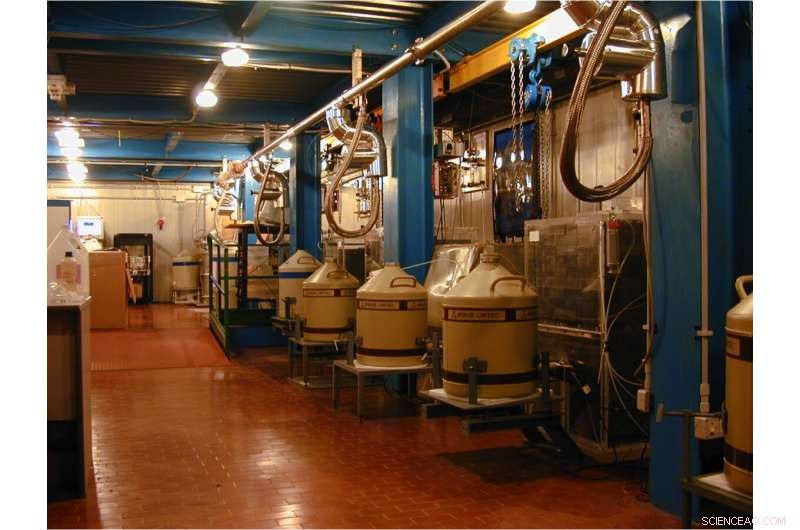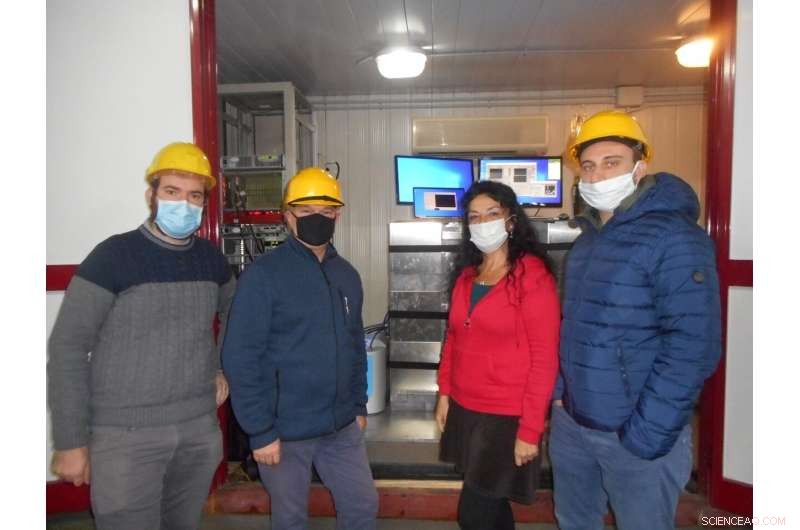
O laboratório de baixa radioatividade Gran Sasso. Crédito:Massimiliano De Deo, LNGS-INFN
A origem da consciência é um dos maiores mistérios da ciência. Uma solução proposta, sugerida pela primeira vez pelo ganhador do Prêmio Nobel e pelo matemático de Oxford Roger Penrose e pelo anestesista Stuart Hammeroff, da Universidade do Arizona, em Tucson, atribui a consciência a cálculos quânticos no cérebro. Isso, por sua vez, depende da noção de que a gravidade pode desempenhar um papel em como os efeitos quânticos desaparecem, ou "colapsam". Mas uma série de experimentos em um laboratório nas profundezas das montanhas Gran Sasso, na Itália, não conseguiu encontrar evidências que apoiem um modelo de colapso quântico relacionado à gravidade, minando a viabilidade dessa explicação para a consciência. O resultado é relatado na revista
Physics of Life Reviews .
“Como a consciência surge no cérebro é um grande quebra-cabeça”, diz Catalina Curceanu, membro do think tank de física, o Foundational Questions Institute, FQXi, e a física líder nos experimentos do INFN em Frascati, Itália. "Existem muitas ideias concorrentes, mas muito poucas podem ser testadas experimentalmente."
A física quântica nos diz que os gatos podem estar vivos e mortos ao mesmo tempo, pelo menos em teoria. No entanto, na prática, nunca vemos felinos presos em um estado de limbo tão infeliz. Uma explicação popular para por que não é porque a "função de onda" de um sistema - seu caráter quântico permitindo que ele esteja em dois estados contraditórios simultaneamente - é mais provável de "colapsar" ou ser destruído se for mais massivo, deixando-o em um estado definido. estado, morto
ou vivo, digamos, mas não os dois ao mesmo tempo. Esse modelo de colapso, relacionado à gravidade agindo em objetos pesados como gatos, foi invocado por Penrose e Hammeroff ao desenvolver seu modelo de consciência, 'Orch OR theory' (teoria da redução objetiva orquestrada), na década de 1990.
Cálculos quânticos no cérebro Curceanu se interessou pela teoria Orch OR quando conheceu Penrose, também membro do FQXi, em uma conferência alguns anos atrás. A consciência geralmente não é associada a propriedades quânticas porque os efeitos quânticos são frágeis e difíceis de manter, mesmo sob condições altamente controladas e temperaturas frias no laboratório. Portanto, há muito se supunha que o ambiente quente e úmido do cérebro seria muito perturbador para permitir que os efeitos quânticos sobrevivessem. Mas Penrose explicou que ele e Hammeroff identificaram pequenas estruturas chamadas microtúbulos dentro de neurônios no cérebro que poderiam sustentar efeitos quânticos por curtos períodos – apenas o tempo suficiente para realizar cálculos quânticos. A teoria OR de Orch atribui a consciência a computações quânticas orquestradas ("Orch") por oscilações elétricas nesses microtúbulos. "O que eu adorei nessa teoria foi que ela é, em princípio, testável e decidi procurar evidências que pudessem ajudar a confirmá-la ou falsificá-la", diz Curceanu.
"O que eu adorei nessa teoria foi que ela é, em princípio, testável e decidi procurar evidências que possam ajudar a confirmá-la ou falsificá-la."
No centro da teoria está a ideia de que a gravidade está relacionada ao colapso da função de onda quântica e que esse colapso é mais rápido em sistemas com mais massa. Este conceito foi desenvolvido em vários modelos por vários físicos na década de 1980. Um deles foi Lajos Diósi, no Wigner Research Center for Physics e na Eötvös Loránd University em Budapeste, Hungria, que foi coautor do novo artigo com Curceanu, Maaneli Derakhshani da Rutgers University em New Brunswick, Nova Jersey, Matthias Laubenstein também do INFN, e Kristian Piscicchia do CREF e do INFN. Penrose independently approached this idea a few years later and it became the core of his consciousness theory with Hammeroff.
The two theories are often referred to by the umbrella term, the "Diósi-Penrose theory." But behind the joint name there is an important difference, notes Curceanu. Diósi's approach predicts that collapse would be accompanied by the spontaneous emission of a small amount of radiation, just large enough to be detected by cutting edge experiments.

Left to right:Fabrizio Napolitano, Alberto Clozza, Catalina Curceanu, Marco Miliucci -- all from INFN-LNF. Credit:Catalina Curceanu
Going underground Curceanu's underground lab is housed within the Gran Sasso National Laboratory, 1.4 km under the Gran Sasso Italian mountains. The lab stands on one side of the 10-km long highway tunnel which crosses the Gran Sasso massif, connecting L'Aquila and Teramo. "The location was chosen because it is basically free from cosmic-ray radiation sources above the ground, that could interfere with the experiment," says Curceanu. The experiment uses an extremely sensitive cylindrical detector, not much bigger than a mug, made from highly pure germanium. It is surrounded by shielding, made of layers of ultra-pure lead and copper, to shelter it from any background radiation coming from the rocks. After running the experiment for two months the team did not measure spontaneous radiation signals, constraining the feasibility of gravity-related collapse. In 2020, the team reported in
Nature Physics that their negative result had helped them rule out the simplest version of the Diósi-Penrose model.
In their new paper they have explicitly examined the repercussions of their finding for Penrose and Hammeroff's Orch OR theory of consciousness. After reanalyzing the most plausible scenarios set out by Hammeroff and Penrose, in light of their recent experimental constraints on quantum collapse, they were led to conclude that almost none of the scenarios are plausible. "This is the first experimental investigation of the gravity-related quantum collapse pillar of the Orch OR consciousness model, which we hope will be followed by many others," says Curceanu. "I am very proud of our achievement."
Interdisciplinary characteristics The experiments and analysis are partially funded by a grant from the Foundational Questions Institute, FQXi. "Without it, it would have not been possible to achieve this outcome," says Curceanu. "It is hard to otherwise get funding for projects such as this, based on its interdisciplinary characteristics."
"It is really exciting to connect what you can do in the laboratory to perhaps the biggest mystery in the universe—consciousness."
But all is not lost for Orch Or, adds Curceanu. "Actually, the real work is just at the beginning." she says. In fact, Penrose's original collapse model, unlike Diósi's, did not predict spontaneous radiation, so has not been ruled out. The new paper also briefly discusses how a gravity-related collapse model might realistically be modified. "Such a revised model, which we are working on within the FQXi financed project, could leave the door open for Orch OR theory," Curceanu says.
Meanwhile the team is preparing to test these refined new collapse models, to further investigate their implications for the Orch OR model. "It is really exciting to connect what you can do in the laboratory to perhaps the biggest mystery in the universe—consciousness," says Curceanu.
+ Explorar mais Deconstructing Schrödinger's cat

